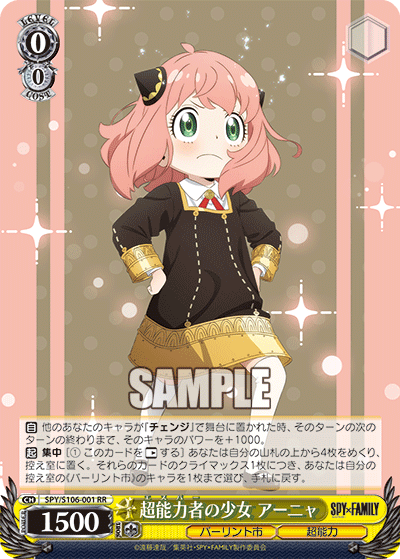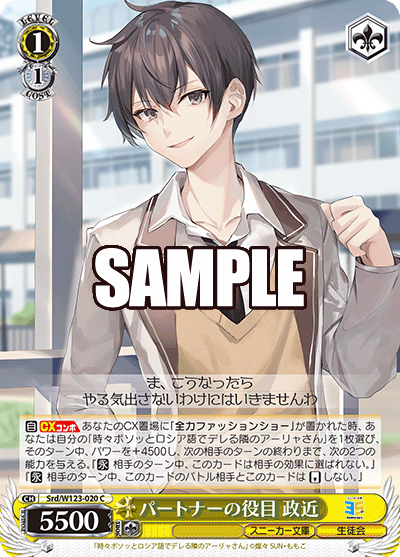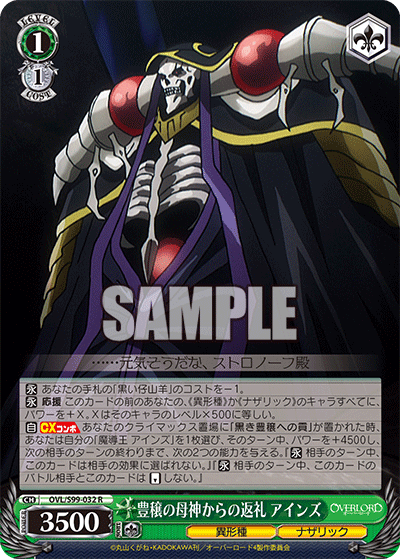In SpyxFamily, one of the key mechanics for the series involves “CHANGE”. The mechanic of CHANGE involves the Forger family members swapping forms between their civilian and secret identities. This is a very fun idea as characters will swap between two different cards, giving them a brand new set of abilities.



SPY/S106-034R 完璧な父親 ロイド (center)
SPY/S106-035SPY-SPYR 元気な娘 アーニャ (right)
The main CHANGE cards are shown above. Each of these cards transform back and forth between these civilian identities and the splashy true forms shown below. Note that the timing for these cards above are all the same, occurring at the start of your opponent’s encore step, creating the idea that these cards are swapping from their more docile civil forms to their more powerful true selves during your turn. Keep in mind that both forms must remain alive as they marker each other and swap into each other at the start of different phases of the game.



SPY/S106-059RR 〈いばら姫〉 ヨル (center)
SPY/S106-003SEC-SEC おそろいのキーホルダー アーニャ (right)
In all earnestness, I personally love the flavour of this mechanic. It feels kind of like a day and night cycle where everyone dons on different masks based on the stage of the game. It really speaks to the core identity of the SpyxFamily series, a comedic slice-of-life tale featuring a fabricated family whose individual members all share secrets hidden from one another.
Now as for why this mechanics isn’t very good in practice, this may surprise you as the pay-offs for these abilities are quite fair and balanced. While the civilian versions give each character some kind of supportive ability either through a healing effect or way to gain advantage, their true identities perform finishing effects to close out the game. Given how there is no real CHANGE costs, especially true since these cards are level three cards, it’s a generally fair exchange in my opinion.
What goes wrong tends to be timing and complications of CHANGE. For the CHANGE to be meaningful, these cards have to be employed early to let you take advantage of the swapping forms. The problem is, most of the time, the true identity forms are better ran alone without their civilian counterpart (outside of Anya). The rationale for this is due to the rapid pacing of the game and overall complications to get the early play conditions.
While yes, all three characters can be spawned as early as level two, the civilian changers are rather clunky and the timing is awkward. Furthermore, you need to meet very specific conditions on top of the general requirements to play the 3/2 finishing options.



SPY/S106-075U お仕事の電話 (center)
SPY/S106-023U 星獲得 (right)
So here’s the catch. To make value out of the civilian roles, we need to get them out on field as early as possible so they can perform their main effect, letting you swap between them and the finisher role. Each of the family members have their own way of spawning their finisher, but the costs are quite varied.
The worst of these in my opinion is Loid’s. Loid’s event spawns out your Loid finisher for free from the waiting room at the cost of a delayed turn. This means that you have to spend one turn putting the events into memory and then valuing off them the next turn. The changers need an extra turn just to have the potential chance to be played. Loid will need you to preemptively prepare for two turns in advance, a tough call considering how fast the game is. Juggling a waiting room condition and a handful of other cards makes it tough to even consider the civilian role. Yor’s problem is more of a resource complication. Yor’s pairing carries a disconnect with the costs of her early play condition with the her civilian role’s effect. Yor’s early play condition costs a massive amount of hand, and with her civilian role costing her even more hand for a heal to stock, this massively depletes your already neutered hand.
The only exception to this rule is Anya. Anya’s combo is very cheap on costs and her civilian form just acts as a free bonus to compliment her style of gameplay. However, therein lies part of the issue. These changers aren’t exactly core to the design and gameplay of their respective decks. They are simply add-ons that provide additional value that mostly work to help you win harder.



SPY/S106-104PR 立ち上がる ロイド (center)
SPY/S106-022SPY-SPYR はは仕込みの必殺パンチ (right)
There is some CHANGE support available in the set. I will speak about the 0/0 Anya brainstormer in a little bit, but let’s go over these cards. Here is the problem. These cards are either too niche in design or far too heavily costed. Loid on the left is likely built to synergize with the other WISE agent combo with Fiona. However, this doesn’t address one of the main concerns with Fiona, fixing and filtering the plus she gets from her combo. Added power is nice, but this card is extremely niche and only affects very specific cards. Secondly, the Loid in the center is a great way to access your cards with the CHANGE keyword from your deck. The problem is that his costs are absurd by 2025 standards, costing you to tap two characters and also discard a climax specifically. Lastly, Anya’s event does provide a very niche yet useful ability by granting all your characters with the keyword CHANGE with power and hexproof, but this effect is not permanent as the event will sacrifice itself at end of turn, and hexproof can be kind of niche depending on the situation. Furthermore, this event only really works in Anya’s deck for colour reasons, and despite being bondable, the card is underwhelming and far too niche. As a whole, these CHANGE cards do not benefit CHANGE all too much and sadly relegate the whole concept of switching identities to just a side mechanic.


One sort of cute, but mostly annoying interaction and more likely an oversight by the design team, was the combination of Anya and Fiona above. So story-wise, these two really have nothing in common and both of them rather dislike one another. But more so, the general idea is that Fiona would swap forms back and forth while being buffed by Anya who would give cards that come in from the waiting room from CHANGE with additional power. I highly doubt this was meant to be, but this made Fiona quite an annoying card to take out on the board as her defensive half would reach absurd numbers. I highly doubt this was the direction that the design team wanted this card to be used. This once again highlights the fact that CHANGE was more of a secondary mechanic over any meaningful main design for the series.


In summary, while extremely flavourful and fitting for the series of SpyxFamily, the overall CHANGE mechanic feels dull and underutilized. The CHANGE cards, specifically the green civilian forms for the finishers, are rather weak and unimpactful. They are fair, but given the speed of the game and the rather mediocre abilities of these CHANGE targets, they are seen more as an afterthought you could include in your deck for some light bonuses. One of the biggest problems is that you need to actively have several copies of these civilian forms in your deck, hindering your draws and often being more so deck filler. Furthermore, consider that these cards, with their main purpose being to swap between forms, can only do so if the finisher form survives on field to begin with, making the card essentially dead weight when played from hand most of the time.
So how do we improve upon these civilian forms? The first point we need to highlight is their main purpose. While healing, getting hand, and etc., is their first ability, this is not the main highlight of the civilian roles. That would be the main mechanic of CHANGE, letting you freely warp them back into the other finishing form. To make these effects more relevant and also encourage and make the CHANGE more feasible, my first primary suggestion is to provide a more useful support card to ensure that at least one single copy of the civilian counterpart will last until your following turn to give you at least a single copy of a finisher to reuse. I think a modified version of Masachika or Ainz would greatly benefit the deck, making the civilian form much more resilient so you can make use of the CHANGE mechanic.
In order to also help with consistency and make these cards less cumbersome to have in your decks, I would modify their CHANGE ability to allow the civilian forms to be spawned from the deck and waiting room, making them less of a liability or clunky combo piece lying around. Ultimately, in the current landscape of the modern game, and even during the release of SpyxFamily, the CHANGE mechanic was rather underwhelming. While maybe keeping a single copy of a finisher essentially invincible for a one full cycle (both yours and your opponent’s turn) may be overly powerful, without allowing these cards to perform their main ability, these CHANGE cards, mainly the civilian forms, are simply underwhelming. We think that by having some of these suggestions implemented, this would allow these cards to see more play.